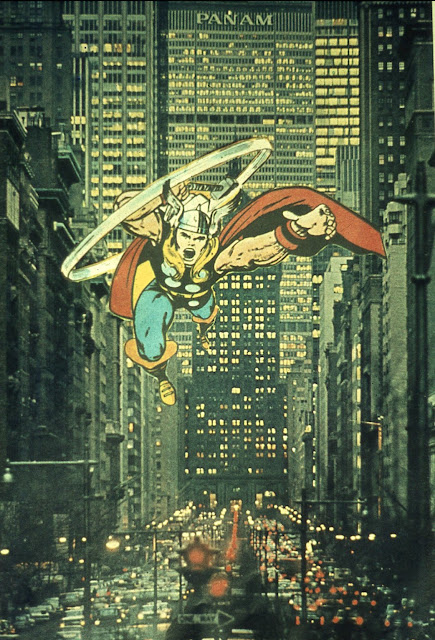In the UK, as teenagers in the 70s, we all lived on the coat-tails of the US pop-culture experience. American comics had been my first insight into the US experience ; in colour, and full of ads; ads for toys we could only dream of, small ads for X-ray specs; ads for huge amusement parks, and ads for TV cartoon shows on Saturday mornings!! What a place! And as the 70s progressed, and as the UK caught up with colour TV and the UK TV scene was overrun with American cop shows, my desire to sample the US pop culture experience first-hand became more and more acute.
 |
| © DC. Aquaman #57 - my first comic bought in the US |
And at age eighteen I finally got to go on a 3-week holiday to the US in Summer of 1977, visiting my uncle and aunt who lived in West Caldwell, New Jersey, a mere bus ride to the Big Apple, Manhattan. Within 24 hours of arriving from England I was desperate to buy a comic - any comic - and so I found a sealed polythene bag containing two comics in a store called Fiegelson’s on Bloomfield Ave in Caldwell, New Jersey. These two comics - the first two comics I bought in the US - were Aquaman #57 and Batman #290.
 |
| © Ian Baker. Fiegelson's , Bloomfield Ave, Caldwell, NJ. July 14 1977 |
It was July 14, 1977. The comics had hit the newsstands as individual issues two months earlier, so I presumed the double bagging was an effort by the distributors to sell old stock, (a practice that was still happening in the early 2000s when Toys-R-Us packaged old Marvels and DCs haphazardly in bags of 10 or 20 comics). Back in the late 70s/early 80s these poly-bag comics were sold by Whitman, and DC had a deal to print the Whitman logo instead of 'DC' on the comics being sold in this way. I honestly cannot remember if the comics I bought in that day had the Whitman logo. They are now sought out by some US collectors as rare variants.
 |
| © Ian Baker. Holding the actual bag - July 14th 1977. |
I was pretty excited to not only get the latest Batman but to find that the Aquaman series drawn by Jim Aparo had been resurrected from its cancellation six years earlier, picking up at issue #57. I read the Aquaman issue first.
The Aquaman story was written by David Michilinie and drawn by series artist Jim Aparo. It was the next issue following #56 “The Creature That Devoured Detroit” which had been published in the Mar-April 1971 issue, a full six years earlier.
In the interim, the Aquaman saga had continued within the pages of Adventure Comics from issue #441 to #452, and so the tale I was reading was the conclusion of a convoluted saga wherein Black Manta had killed Aquaman's son, Arthur Jr.. The mixture of melodrama and high adventure in the pages of Adventure Comics was sufficient to warrant the resuscitation of the Aquaman comic book with stories in the same vein, but was a far cry from the type of story that Steve Skeates had been writing in issues #40-#56, which had touched on socially conscious issues of pollution and climate change as a counter-balance to our hero's exploits.
Jim Aparo continued to deliver outstanding artwork in Aquaman #57, but the challenge of fitting the story into 17 pages lead to many, very small panels, on each page. The story was actually a conclusion to an arc of stories by Dave Michilinie in the pages of Adventure comics which had culminated in #452. The story in Aquaman #57 would have benefited from running as two 12-page stories, to give the tale room to breathe.
I found the frenetic pace of the action too busy for my tastes, and missed the more detailed artwork and slower pacing that Aparo had delivered six years earlier back in issue #56, with delicate shading and tones. See comparison below.
 |
| © DC. Frenetic pacing and crammed artwork in Aquaman #57 |
 |
| © DC. Great shading and tones from Aquaman #56, from six years earlier |
However, the I was impressed enough to continue to pick up Aquaman going forward.
I'll cover the Batman comic in a later blog.
Random Observations:
- The interaction between Black Manta and his mentor on a submarine in the pages of Aquaman #57 is very reminiscent of a similar scene near the start of the recent Aquaman movie.
- Re-reading the previous issue, Aquaman #56, I was reminded that the abrupt ending to that storyline by Steve Skeates in 1971 was the jumping-off point for Steve Skeates' story in the final issue of Marvel's Sub-Mariner #72 in 1974.
Aquaman #56 ends with Aquaman destroying a rogue satellite, and Sub-Mariner #72 begins with the same scene with no explanation of context. Another unofficial DC/Marvel crossover! (Someone should have told colourist Linda Lessmann to make the glove green in the Sub-Mariner issue).
See comparison below.
 |
| © DC. Aquaman #56. Story by Steve Skeates |
 |
| © DC. Final panels from Aquaman #56 |
 |
| © Marvel. Story opening in Sub-Mariner #72 |
 |
| © Marvel. Sub-Mariner 72 - story by Steve Skeates. |










